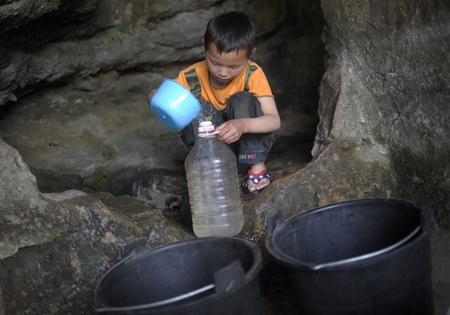Top Biz News
Efforts made to ease SW drought
(China Daily)
Updated: 2010-03-29 09:34
 |
Large Medium Small |
Almost twenty million people left thirsty by rare water shortages
Niu Siwei's sense of unease grows every time he hears his students cough.
After eight months with no rain, the village school where he teaches in Nanhua county, Chuxiong, an Yi ethnic prefecture in southwestern Yunnan province, has been using water from a local fish pond for cooking.
The foul water is sterilized with bleach powder so the meals for the 192 students, aged seven to 12, always smell strongly of the chemical.
"At the beginning, the cook believed the more bleach powder he used, the safer the water would be," said Niu. "Once he put 10 grams in 100 kg of water, almost 10 times the safe amount."
Last week, some thirsty students took a few mouthfuls of unprocessed pond water, and became sick, vomiting and suffering from diarrhea.
The once-in-a-century drought that has left almost 20 million people thirsty in China's southwestern localities, including Yunnan, Guizhou, Guangxi, Sichuan and Chongqing, has aroused widespread concern.
As a result, donations of drinking water are arriving.
Nongfu Spring Co, a bottled water producer in the eastern province of Zhejiang, was the latest donator. It decided last Monday to send 13 million yuan of bottled water to the drought-hit province.
The donated water, however, averages only 600 ml a day for each student, less than half of the daily per capita requirement.
Three times a week, Niu takes his students to fetch water from a pond 1,000 meters from the school. "Even the girls carry about their own weight in water, and a two-way trip takes only 15 minutes," he said.
But the pond, too, has little water left.
Chuxiong, one of the poorest areas in China, is not alone.
In Qujing city, many villagers have to wait 48 hours before they can fetch a bucket of water at the few sources still in service.
Every day, five-year-old Liao Mingbo joins the queue, carrying 2.5 kg each time. "It's not heavy. I've been doing this for many months," he said.
Liao's fellow villagers in Huize county must walk about two and a half hours to get to a river for water.
|
||||
The drought has damaged at least 3 million hectares of cropland in Yunnan province, according to figures released by the national flood prevention and drought relief headquarters in Beijing. Many peasants complain all their wheat, beans and vegetables have died.
The drought has cut the province's power generation capacity by 30 percent, as it largely relies on hydroelectricity, and water flow in the Lancang River, Asia's third longest, was down by half compared with last year.
If the drought continues, almost a quarter of the local population will suffer drinking water shortages by May, said Zhou Yunlong, chief of water resources in Yunnan.
The province has a population of 45.5 million, according to the most recent census in 2008.














